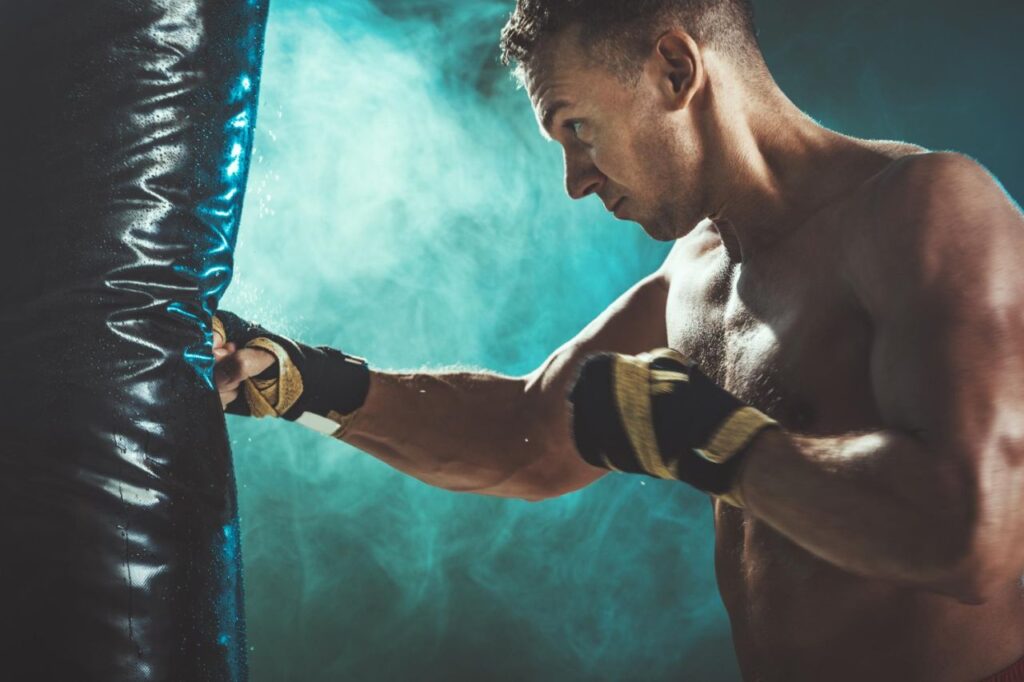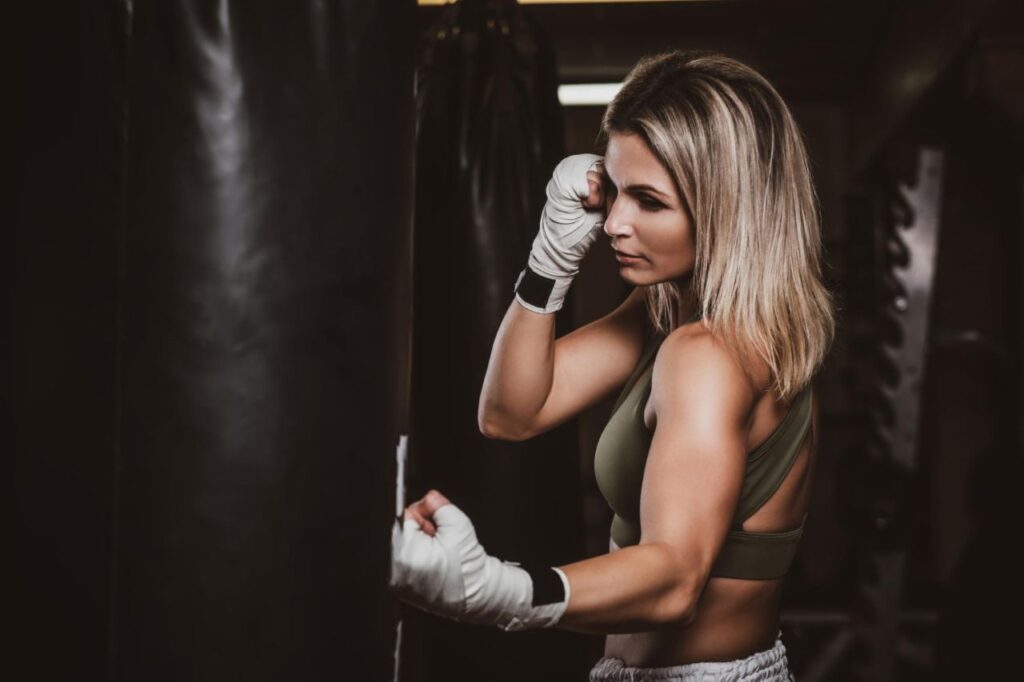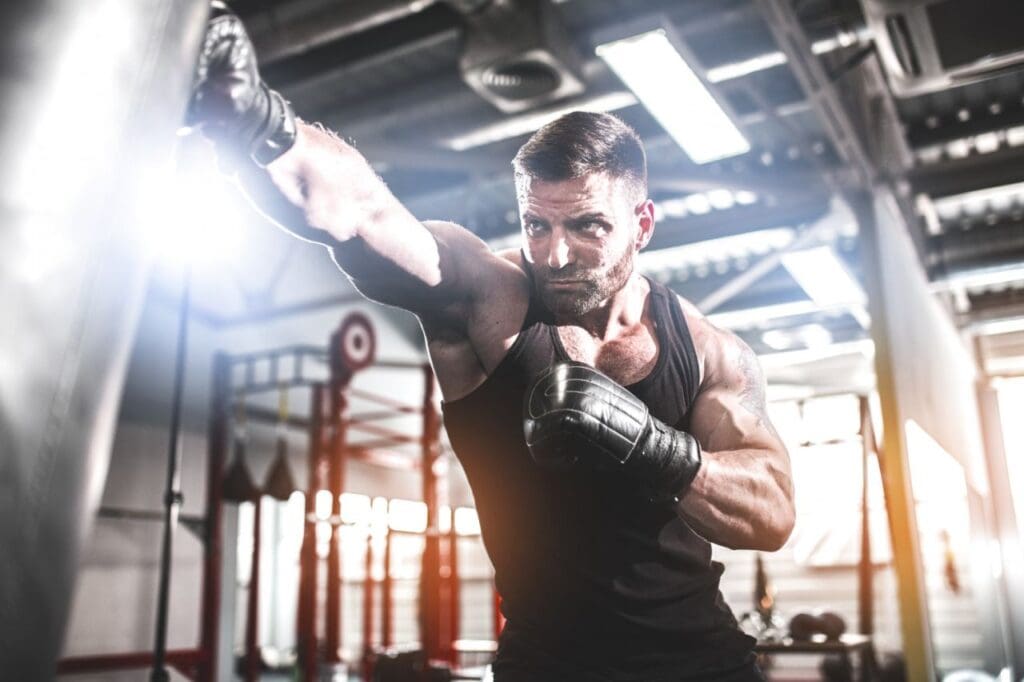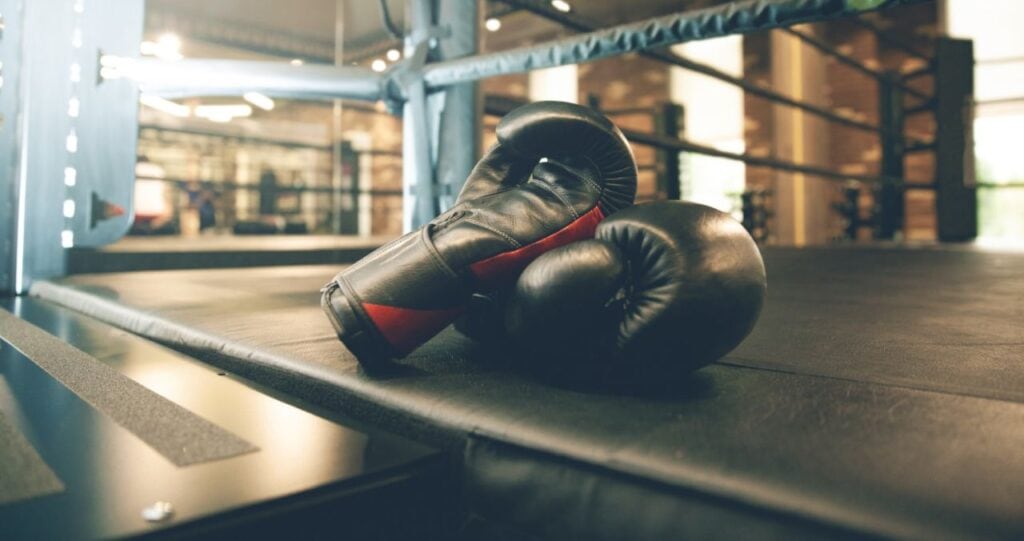Are you looking to start boxing, but don't have the money for a bag? No problem! You can still get a great workout by using some simple techniques and your own body weight. In this post, we'll show you how to do shadow boxing and basic punches without a bag. Let's get started!
Ways To Box Without A Punching Bag
When you close your eyes and think of Boxing, what comes to your mind? Probably you see a well-built man practicing punches with his gloved hands on a punching bag and throwing sweat all over while he does this.
Punching needn’t be like this every time. There are techniques and alternatives to a punching bag. They allow you to get the workout you need while saving resources such as space.
Boxing Without A Punching Bag:
Boxing is a combat sport and was made popular by movies like Rocky. Today, this martial art is also an accepted workout form. Boxing has many advantages. It improves endurance, cardiovascular health, burns fat, and improves stamina and confidence levels. Boxing helps in building and toning your muscles.
When you are feeling stressed out, boxing is a great way to let off all the steam and helps you cool down and relax.
While boxing is most commonly practiced using a punching bag, having access to a punching bag may not always be possible, especially at home. Buying a bag costs money and you will need space to put it. When these resources are limited, you can even box without the use of a punching bag.
We will list down different popular ways of boxing without a punching bag, and how you can go about with each of them.
Boxing FAQs:
Is It Bad To Punch A Punching Bag Without Gloves?
No. It isn’t bad to punch a punching bag without gloves. Punching without gloves will help strengthen your wrist, forearm muscles, and knuckles.
But you must not do this frequently as the bones and your wrists and hands aren’t that strong.
You can use different gloves such as boxing gloves, hand wraps, MMA gloves, etc., interchangeably for the best results.
Can You Get Ripped From A Punching Bag?
The quick answer is yes, you can. The detailed answer is that it may not be easy. Basic boxing alone may not get you the chiseled look. You must combine high-intensity boxing with other workout forms such as strength training and circuit training exercises.
Is It Ok To Punch A Wall?
Punching a wall should be strictly avoided, especially if you are new to boxing. You can hurt your wrists and knuckles. You can do this only when your wrists and knuckles are sufficiently conditioned to take the blow or under expert guidance.
Can You Learn To Box By Yourself?
The good news is, yes, you can learn to box by yourself. There are many online videos, blogs, articles, and phone apps that can help you with all the training you will need. However, it is always a good idea to train with an expert first. This will help you learn the basics first.
What Can I Use Instead Of A Punching Bag?
There are many alternatives to punching bags such as floor bags, speed bags, boxing reflex balls, and punch balls with stands. Alternatively, you can use techniques such as shadow boxing. Adding weights to wrists is also a popular method of boxing without punching bags.
Four Popular Ways To Box Without A Punching Bag:
Shadow Boxing:
When you do not have a punching bag or an opponent to throw your punches at, you can incorporate a training technique known as Shadow Boxing. As the name suggests, you are boxing with a shadow or throwing punches in the air.
Shadow Boxing is a good workout option when you do not have the necessary boxing gear. Just find yourself a room that is spacious enough to move around and throw punches, and you can start with shadow boxing.
Punching into the air may sound pointless. But it is a great technique to improve your concentration and stamina. Many trainers teach aspiring boxers shadow boxing first before teaching them actual boxing techniques on opponents.
Seasoned boxers use shadow Boxing for warm up before entering the boxing ring.

Shadow Boxing for Beginners:
If you are new to Shadow Boxing, we outline a few simple steps to introduce you to box without a punching bag.
- Learn your stance:
Most boxers prefer putting their left foot in front of their right when starting to box. You can choose to put your right foot in front of your left. The stance is important. Change your stance frequently while boxing.
This will help you easily move around your boxing space.
Changing your stance frequently will also help you work out your muscles on both sides of your body. Move forward, backward, and sideways to ensure a full-body workout.
- Set your arm position:
Bend your elbows and place them close to your ribs. Imagine protecting your ribs from your opponent. Now make fists with your hands. Your thumb should cover your four fingers while making this fist. Hold your fists next to your face.
- Start throwing punches:
Start by putting weight on your front leg and extending the same arm forward.
The arm should be parallel to the floor, and your palm should face downward. Your other hand should be protecting your face. Now change the position and place the other leg forward.
While doing this shift your body’s weight onto the foot so that your hip moves forward.
Place the first hand in a hook position at a 90 degree and angle and punch the air in front of you. Push the other arm forward parallel to the floor and your palm facing downward.
- Combine stance and punch:
Once you get comfortable with your stance and punch, simply combine them for a full-body workout.
Shadow Boxing is all about imagination.
You can add ducks and squats as a means to avoid punches from imaginary opponents. You can also punch at different levels while imagining hitting your opponent on their head or stomach.
Your imagination makes Shadow Boxing interesting and helps avoid monotony when working out alone.
Focus Mitts:
Another excellent alternative to shadow boxing is boxing using Focus Mitts. These mitts are padded surfaces attached to gloves. You will need a partner when boxing with the help of focus mitts. Your partner will wear these mitts and the pads become your boxing target.
Focus Mitts were used in the ancient far East Asian Martial Arts and were extensively used in the martial art of Muay Thai. Martial Art Guru Bruce Lee is credited with popularizing the use of padded Focus Mitts in the mid-60s.
During the late 70s and early 80s, these alternatives to boxing without a punching bag slowly started finding a place in training routines across training academies. Today, Focus Mitts are an essential training gear for boxing and workouts.
When training using Focus Mitts, your trainer or companion will yell numbers that represent the combinations of moves you have to perform. For example, when they yell 1, 2 and 3, you may have to do a jab, a cross, and a hook movement in quick succession.
Your trainer/companion will be ready with counter moves or defense, which will help you learn the technique and maneuvers when boxing without a punching bag.
Wrist Weights:
The primary purpose of wearing wrist weights is to increase resistance to your movements, thus providing for better workouts.Wrist Weights Wrist weights are significant because your hands are free and you don’t have to worry about holding something constantly while training. They provide you with all the resistance you need.
You can start with weights of about a pound for both your hands together if you are training for the first time.
As you progress and get comfortable, you can increase the weights. Most professional trainers and boxers wear weights of 2 pounds and this is considered ideal.
Wearing wrist weights is an excellent alternative to shadow boxing because it helps you lose as much weight as you would lose when wearing boxing gloves, maybe a little more. Wearing weights also gives you a full workout because of the resistance the weights provide.
Wrist weights help improve your shoulder endurance because of the extra weights.
You should wear wrist weights only when boxing without a punching bag. If using a punching bag to train, wearing wrist weights can cause injuries.
Tires:
Car tires are similar to punching bags. They are strong and soft and provide an excellent alternative to box without punching bags.
Tires are a great DIY alternative to punching bags. You will need 5 or 6 tires. Place them one over the other, make sure they stand firm and are attached well to one another.
Once you are ready with this setup, you can start practicing. Always wear gloves when using tires to practice your boxing moves. This will help avoid any possible injuries.
Follow the standard boxing instructions for beginners. You can practice different stances, punches, and combinations as you get comfortable boxing using tires.
Basic Boxing Punches
When you break it down to the basics, there are 4 types of hits in boxing. As a boxer you have to master the jab, cross, hook, and uppercut.
Jab
The set up punch, jab is the most used weapon a boxer has.
It is fast and has little power behind it but when used right, it can set up much more powerful hits.
The jab is also effective in keeping an aggressive opponent at bay, because they will be wary of other punches to follow.
- Take up your boxing stance and keep your stance straight.
- Extend your arm (right or left) straight in front of you.
- Do not move your body in any other way.
- The next movement you need to learn is the rotation of the arm.
- You will rotate the entire lower arm – wrist, elbow, and palm – while you throw the jab.
- From your stance the arm should rotate in a way that your palm is facing the floor.
- Speed is key, not power.
- Don’t think above hitting, think about snapping your arm towards your opponent’s head like whip.
One mistake that beginners often make is that they give signs to their opponent when throwing a jab.
They load their bicep and twitch their arm muscles, giving opponent the signal to prepare a counter punch. Avoid telegraphing the jab.
Keep your arm ready and snap out the jab without any extra movement.
Cross
After practicing your jab, you can move on to the cross.
This punch is much more powerful than the jab and requires body and leg movement to get right.
You will use your dominant hand to throw the cross.
- Take your fighting stance.
- Twist your hips and pivot your back foot.
- The back foot’s ball should be ground on the floor.
- After getting this movement down, throw the punch.
- Do it slowly at first. Extend your arm while rotating it and follow the body movements mentioned above.
- You have to generate power while being precise with the cross.
- While you throw the cross, keep your head hidden behind your shoulder to avoid damage from any possible counter punches.
Do not extend yourself or lift your back foot while throwing a cross. It will leave you unbalanced and open to counter punches from your opponent.
Hook
A perfect hook requires your whole body to twist along with your fist. It should be one smooth motion. The hook can be thrown with either arm so you will have to practice with both.
Get in front of a heavy punching bag to practice the hook.
- Get in your stance.
- Plant your back foot on the ground firmly.
- You should be on the ball of your front foot.
- Raise the elbow of your arm (left or right) to shoulder height and keep your elbow bent at 50 degrees.
- Throw the hit while twisting your body and the lead leg, the lead foot should grind on the mat while rotating.
- Generate all the power you can from the body movement.
- Keep your other arm near your chin to protect yourself.
- Rotate your body back fluidly.
- Start adding more speed to the movement and get back to your stance as quickly as possible.
You have to get back to your normal stance immediately to avoid any counters. You can create more space between the bag and yourself and try to extend the hook, only after you have got the basic movement down.
Uppercut
The uppercut can be one of the most devastating punches, whether it is thrown at the body or head. Your lower body is the key in generating power in the uppercut.
- Start with your normal stance.
- Bend your knees slightly. The back knee should be more bent than the front one.
- Bring your elbow down, drop your shoulder slightly, and throw the punch while making a scooping motion upwards.
- Elbow should be bent at 50 degrees the whole time.
- Rotate your arm so your palm is facing towards you.
- Shift the weight from your rear to front leg while you are throwing the punch.
- After making contact, bring the glove back to your chin quickly.
Uppercut can be thrown with both arms so practice both arms by alternating the movements. Again, try not to telegraph the punch by making massive scooping movement. Keep it tight and throw it as fast as possible.
Practice, practice and then some practice. That is the only way that you will get the movements right. Get your lower body involved wherever necessary because without it you will not have any power in your hits.
The heavy bag will be your best friend until you get these punches right, soon they will become a part of your muscles memory and you will throw them without making any extra movements.
How To Choose The Right Punching Bag For Your Workout
Choosing the right punching bag is the key to improved workout performance and success in your at-home boxing training.
With so many options and sizes available, it can be difficult to determine which heavy bag is right for you, especially as a beginner boxer.
We’ll show you how to pick the right boxing bag for at home use.
Which Type Of Punching Bag Is Best?
Punching bags come in all shapes and sizes. They each have their own pros and cons and the “best” one for you depends on your needs. The first thing you need to do is determine where your training space will be and what kind of boxing bag is best for your space.
Here are some of the different options you can choose from:
- Heavy bag
- Free-standing punching bag
- Speed bag
- Boxing bag with stand
- Hanging punching bag
What Types Of Heavy Punching Bags Are There?

Heavy bags—like the name implies—are punching bags generally weighing up to 200 pounds. There are two types of heavy punching bags you can use:
- Traditional hanging bags
- Free-standing punching bags
Traditional hanging punching bags are usually attached to the ceiling or a stand and swing when kicked or punched. Free-standing punching bags are fitted onto a base that provides a stable foundation.
Generally, heavy bags are used to improve punching and kicking skills. Heavy bags may be used in a number of different combat sports including boxing, kickboxing, Muay Thai, taekwondo, and karate.
How To Pick The Right Size Heavy Punching Bag
If you’re wondering what weight and size of heavy punching bag is best for you, the general rule is that heavy bags should be approximately half your body weight. A 200 pound person may find a 100 pound bag suitable for use. For most adults, hanging bags should be at least 80 pounds to provide a good experience.
Here are some basic guidelines regarding various punching bag weights:
- 40 pounds: optimal for youth boxers and young beginners
- 70 pounds: designed for teenagers and beginners
- 100 pounds: suitable for intermediate boxers
- 200 pounds: designed for heavyweight boxers
Heavy bags are versatile enough to fit within all different types of fighting and boxing training styles.
When Should You Use A Free-Standing Punching Bag?
Free-standing bags are punching bags that do not require mounting. These bags are typically attached to heavy bases weighted down with sand or water.
Free-standing punching bags are great for practicing various kicking techniques, or for use in rooms with limited wall installation options. These types of heavy punching bags are portable and can be placed in living rooms or bedrooms for easy accessibility and storage.
They don’t require professional installation which can save on setup costs as well.
Reasons Why Heavy Bags SUCK
YES, it’s true – hitting a punching bag all day might hurt your boxing skills. The main reason why is because over-training on a heavy bag makes it easy for boxers to develop bad habits.
Honestly, heavy bags don’t suck. There are just some negatives and disadvantages to using heavy bags all the time.
Lazy Eyes
MISTAKE – The number one problem that I’ve seen with heavy bags is that it develops what I like to call “lazy eyes” in boxers. What happens is boxers get a little too comfortable with the bag and start developing bad habits.
They lose focus and take their eyes off the bag. The eyes start wandering past the heavy bag to look at other fighters in the gym, or they wander over to the mirror to check out their own punches.
Some people look at the bag but aren’t really focused on what they are hitting.
CONSEQUENCE – Have you ever sparred someone in the ring and got punched by an easy punch that was coming straight for you? I remember getting frustrated because I kept getting hit by the same easy straight punches over and over again.
If this is happening to you, chances are, you’re training too much on a bag that doesn’t challenge your eyes to look for movement.
CURE – Use a double-end bag or a trainer with focus mitts. You need something that will grab your eyes’ attention. If you have to use a heavy-bag, make sure you ALWAYS keep your eye on the bag.
When the bag is too close to you, back up so you can see it. Don’t get too close to the bag that it’s touching your shoulders and you’re looking behind it. Always keep the punching bag in your field of vision.
Bad Distance Control
MISTAKE – Some people will never learn how to control their distance with the heavy bag because they’re probably too focused on punching hard. The two common problems are letting the bag get too close, and letting the bag get too far.
A lot of beginning boxers love to get real close to the bag as they unload a barrage of 20 punches to push it away. Other beginners will shove the bag around with their shoulders as if they’re mimicking a clinch.
This is a HUGE NO-NO! Don’t ever get use to this, if you try this in a real fight, you will get uppercutted easily every time. As for letting a bag get too far, this is just plain laziness.
Don’t ever let a bag swing too far away from you, quickly step in with fast footwork, plant your feet and hit it 2-3 times before you step and pivot out of the way. Don’t get into the lazy habit of always waiting for the bag to come at you.
Start chasing the bag more often and circling it to keep up with the bag. If the bag doesn’t swing much, then the bag is too heavy. If the bag swings too much, you need to lighten up your punches or get a heavier punching bag.
CONSEQUENCE – If you don’t learn how to keep your distance and learn the exact reach of your arm, you will lose fights to other boxers that do. You might encounter a boxer one day that for some reason, always seems to be out of your reach yet you are always within his reach.
You might also notice that every time you get too close to your opponent, he keeps beating you to the punch. The reason for all this is because he has a better sense of distance awareness than you do.
CURE – Be aware of your distance. Try not to get any closer to the bag than you need to land the punch. When you are in close against the bag, be VERY alert and quickly pull yourself out of range.
Better yet, STAY THE HELL AWAY FROM THE BAG. Don’t hug it, don’t shoulder-push it, and don’t practice your Mike Tyson ducking movements around it. When the bag comes too close, make sure you back-step.
When the bag swings away, step forward to reach it instead of waiting for the swing.
Bad Defense
MISTAKE – One of the biggest reasons against training too much on a heavy bag is because you might develop a bad defense.
The bag is never going to hit you back so it’s easy for you to get carried away and drop your hands from time to time when you feel tired or over-confident. The punching bag can never tell a boxer if his stance or position has a hole in it.
At the same time, it’s easy for a boxer to get carried away on the heavy bag over time as he slowly shifts his stance from a defensive one to an open one that allows him to hit harder.
CONSEQUENCE – The boxer might go into a fight and get beat up because nobody ever told him he had holes in his defense.
CURE – Work with a trainer or somebody who can punch back at you and make sure you can keep your hands up. Even someone throwing slow punches at you will help you keep your defense in check.
Push Punching

MISTAKE – Many boxers get carried away with the heavy bag and start trying to punch it as hard as they can. What happens is they try to make the bag swing as much as possible by pushing it as they try and punch through the bag.
What this does is slow down their punches since they are busy pushing the bag but it also slows down their arm recovery time since they are too busy trying to push their fist through the back instead of pulling their arm back right away.
CONSEQUENCE – In a real fight or sparring match, the boxer starts overcommitting himself just like he does on the punching bag and starts throwing slower punches because he’s trying to maximize the power.
His arms don’t retract as fast and he starts getting countered all the time because he only knows how to throw push punches.
CURE – Many pro-fighters like to call this, “trying too hard”. I use to commit this mistake all the time, and pro-boxers use to tell me to just relax and not try to always use my power when I box. The opposite of a push punch is a SNAPPING PUNCH.
The snapping punch is much sharper and faster. When you first practice it, it may not feel like it hits hard since the emphasis is more on speed than strength.
Over time if you practice, you will learn how to throw very fast and also hard stinging snappy punches just like Muhammad Ali. They are the BEST type of punches in boxing and if you don’t get past the push punches, you will NEVER be able to compete at the elite level.
Bad Balance
MISTAKE – Another common result of hitting the heavy bag too much is the development of bad balance. Beginner boxers like to focus too much on power and hitting the bag that they let their feet tangle up as they walk around the bag. Another common mistake is overcommitting to the bag and pushing all their bodyweight into every punch.
CONSEQUENCE – The biggest risk of overcommitting to every punch and putting too much power is when you miss your opponent. If you’re throwing all your weight into a punch and you miss the guy, it’s very easy for you to fall out of balance and get counterpunched.
CURE – The best cure for this is learning SHADOW BOXING. Every boxer should know how to throw hard punches and hitting air without losing their balance.
Low Speed
MISTAKE – The problem with heavy bags is that there is no real emphasis on speed. I’ve seen boxers move around the heavy bag and throw all sorts of slow lazy punches because the heavy bag doesn’t force them to throw every punch with speed.
CONSEQUENCE – You’ll lose fights in the ring because your punches aren’t fast enough to get past your opponent’s guard. What’s the point having strong punches if they don’t have the speed to hit your opponent?
CURE – Use a speedbag or double-end bag to make sure your body is being forced to respond with fast accurate punches. This will also increase your accuracy in boxing!
No Uppercuts
MISTAKE – Many boxers that spend all their time practicing on a heavy bag often neglect two very under-used punches in boxing – the left uppercut and the right uppercut! The biggest reason is because they don’t have any of those specially designed bags that allow them to practice uppercuts.
CONSEQUENCE – Obviously, you’re going to have two less punches in your arsenal than your opponent does. The uppercut is very good at breaking tight guards as well as beating fighters that like to move their head a lot as they bob and weave inside your punching range.
CURE – Either start finding equipment that will allow you to throw uppercuts or get someone to hold the pads for you to practice your uppercuts. If worse comes to worse, you can still practice them on a regular heavy bag by throwing low punches with your elbows bent and palms facing upwards at the heavy bag.
Hand Damage
MISTAKE – One of the most common problems I’ve seen from over-training on the heavy bag is damaged hands. If you beat your fists against a very resilient object everyday, your hands will wear down!
Your hand muscles will become bruised and your bones will ache. Sure bones and muscle can harden over time but you must give your body some rest.
I see new boxers hitting the heavy bag for hours every single day in hopes of proving to themselves and other gym-goers how tough they are. Don’t become one of them!
CONSEQUENCE – Once you damage your hand, it will take a very long time to heal and you might not ever be able to punch as hard ever again. If you want some proof, please find someone who’s been in several bar fights and ask them about their hands.
They’ll tell you all sorts of stories about how their hands can’t bend in certain ways or how their hands are always hurting.
Of course, there will always be people who have higher density bones but don’t use this rare statistic as a reason for not protecting your most important weapons – your hands.
If your hands aren’t damaged, you’ll develop other problems like tense shoulder muscles which will decrease your agility and punching speed.
CURE – Give your body some rest and do other exercises to work on your boxing.
Conclusion
So, if you don’t have access to a gym or you want to practice boxing at home, what can you do? First of all, there are plenty of ways to box without a punching bag. You can shadowbox, use focus mitts or Thai pads, hit the speed bag, and more.
Second of all, heavy bags SUCK. They’re uncomfortable to use, they move around too much, and they take up a lot of space. If you’re looking for an effective way to improve your boxing skills without leaving your house, check out our list of alternatives to the traditional heavy bag.
- Find a gym. Boxing gyms aren't typically found in the yellow pages, but there are resources on the internet that can lead you in the right direction. ...
- Be sure the gym is within striking distance. ...
- Be open-minded. ...
- Choose your coach carefully. ...
- Do judge the gym by its cover.
So, can boxing be self-taught? Boxing can be self-taught but it's not the quickest and most effective way to become better at the sport because you aren't able to tap into the knowledge of a boxing coach who would be able to help you one to one.
Best Age to Start
Specialists in sports medicine believe that boxing classes are better to start from 9-10 years. Starting too early could result in putting the student off, as boxing is hard work and not always as fun as team sports, such as football or rugby.

